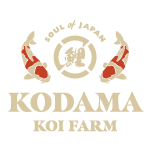Genjiro Koi Farm
Top class Kohaku in Japan inherits its growth nature from Sensuke Kohaku and its deep, beautiful red from Tomoin Kohaku. The Sensuke Kohaku and Tomoin Kohaku both originated from Genjiro Koi Farm.
Learn More About Genjiro Koi Farm
Owner(s): Takashi Kobayashi
Specialty: Kohaku
Description: Mr. Takashi Kobayashi, the present owner, is a fourth generation breeder. His great grandfather, the founder of Genjiro Koi Farm, bred excellent Koi.
These Koi were the ancestors that contributed to the production of Tomoin and Sensuke. Genjiro Kohaku, in this regard, is recognized as one of the origin of the Kohaku bloodline. In Taisho Sanke production as well, Genjiro Koi Farm owns a pure "Sadazo Sanke" which has produced many generations of Koi during the 36 years the Kobayashi Family has owned it. Sadazo Sanke is one of three famous Sanke bloodlines along with Jinbei and Torazo.
It is most likely that Genjiro is the only breeder that uses the pure blood of Sadazo Sanke as its parent. It is due to the purity of this bloodline, that the Sumi and Hi quality are both first class.
Takashi also acquired a number of quality Hikarimono parents from his father (Hirokichi) and breeds the Hikarimono varieties of Kujyaku and Matsuba. As a matter of fact, Hirokichi, Takashi's father was responsible for the stabilizing of Yamabuki Ogon.
Interview with Genjiro Koi Farm
Interview from January/February 2005
Genjiro Koi Farm
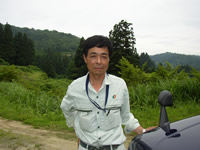
Mr. Takashi Kobayashi, The fourth owner of Genjiro Koi Farm
Genjiro Koi Farm breeds with the pure blood of Sadazo Sanke.
This time, I visited the Genjiro Koi Farm with its history of four generations (Genjiro, Tetsuji, Hirokichi, and Takashi). The current owner of Genjiro is Mr. Takashi Kobayashi, who is 52 years old, and an excellent breeder. I asked him about his Sanke today.
Kodama:
Everybody knows your excellent Taisho Sanke. Why do you call it "Sadazo Sanke of Genjiro" instead of "Genjiro Sanke"?
Kobayashi:
As you know, Sadazo Sanke came to appear 50 years agoand the bloodlineproduced many excellent Koi. At the same time, breeders competed to use them as parents. As the result, it raised the level of beauty in Taisho Sanke variety. Sadazo Sanke contributed a lot to Koi industry. Each breeder used Sadazo Sanke to improve his/her Koi. But nobody preserved the pure line as is and nobody produces Sanke with the pure lines of Sadazo Sanke for both parents. At this point, I do not know anybody but myself.
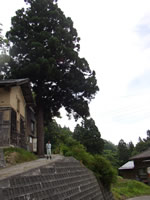
Genjiro cedar 300 years old
Kodama:
Many excellent Taisho Sanke of the Dainichi Koi Farm have the Sadazo blood.
Kobayashi:
Yes. It is not too much to say every Taisho Sanke produced in Japan has Sadazo blood. I do not believe no other bloodline contributed so much to the improvement of Taisho Sanke as Sadazo Sanke. Of course, as you said, the greatest contribution was the bloodline was connected to Dainichi Sanke. But during the 50 years, the Sadazo blood is getting thinner and thinner at any breeders.
Kodama:
I think it is more than just "thin." I think the traces of Sadazo blood are completely gone.
Kobayashi:
Every breeder introduced strength of Sadazo in order to improve his Koi. And of course, the introduced blood will be thinner and thinner over generations. But I am different. I breed Sanke using the "pure blood Sadazo Sanke" for both of the parents. "Pure line of Sadazo Sanke must not exterminate for Nishikigoi industry." "Genjiro preserves the bloodline of Sadazo Sanke." This is the mission I succeeded from my father, Hirokichi.
Kodama:
Respectful thought.
Kobayashi:
Because the blood of Sadazo Sanke is pure and precious, I purposely call them “Sadazo Sanke of Genjiro” instead of “Genjiro Sanke.”
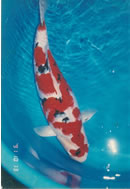
*pic3 Pure Sadazo Sanke - Parent Koi
Kodama:
I see. How thick is the blood?
Kobayashi:
This is direct from the first generation. So the line is the purest you can get. 55years ago, my father, Hirokichi Kobayashi, purchased 10 Tosai from Sadazo in Nigorisawa. He made the original parents out of the 10 Koi and had bred until 1990. Unfortunately, the parent died for the accidents. But their child is here on Picture 3. This Koi is our parental Koi now. This is descended in a direct line from Sadazo Sanke. I believe no Koi in Niigata have purer Sadazo blood than this Koi.
Kodama:
I see. It is terrific. It other words, this Koi is a grand child of original Sadazo Sanke in Nigorisawa.
Kobayashi:
Exactly. I guarantee nobody breeds Sanke with the pure Sadazo Sanke. This Koi on picture 6 won at All Japan Nishikigoi Show. This Koi shows the characteristics of “Sadazo Sanke” very well.

*pic6 Sadazo Sanke won at All Japan Koi show.
Kodama:
Crossing bloodlines is very frequently done in the Nishikigoi industry. It is very rare to have such a pure bloodline.
Kobayashi:
Yes, I agree. This is why I do not call my Sanke “Genjiro Sanke.” Because I want to preserve the precious line, I call them “Sadazo Sanke.”
Kodama:
I think your thought is right. It is very significant to preserve the pure blood in such an industry where crossbreeding is frequently done. It may be important to use the "Sadazo Sanke" instead of the "Genjiro Sanke." I think it helps to preserve and introduce the pure Sadazo Sanke to the world.
Kodama:
Would you please share with us the characteristics of the Sadazo Sanke you breed?
Kobayashi:
Please look at picture 3 and 6. They explain you the characteristics well. The first is the Hi layer. As you can see, Hi layer is very thick. And because Hi is thick, Hi color becomes strong. And because Hi is thick, it is not easily influenced by water quality of the pond. This is a very strong line.
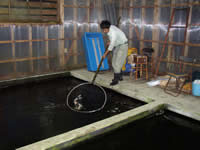
*pic3 Pure Sadazo Sanke - Parent Koi
Kodama: I see.
That is why your koi has a thicker hi plate and stronger colors than other lines.
Kobayashi:
The next is Sumi. At first, it appears in a shape of small balls. In addition, it is top quality Sumi that is deeply rooted inside the body. Lacquer tableware is famous in Japan. Sumi of my Koi has strong lacquer black as if the black lacquer was painted over more than 10 times. This is the characteristic.
Kodama:
I see what you mean. Your sumi definitely carries luster.
Kobayashi:
Of course, there is a weak point in “Sadazo Sanke” of Genjiro. That is that they do not grow big because it carries the blood from 50 years ago. Nowadays, growth more than 80 cm (32 in.) is highly demanded.
Kodama:
Yes, we have been improving koi for them to grow bigger and bigger. It might be natural that the Sadazo Sanke is not likely to grow big because it is carrying the characteristics of 50 years ago.
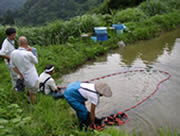
Staff at work
Kobayashi:
We have had 36 All Japan Koi Shows. And the condition to be the grand champion is to grow more than 80 cm (32 in.). The grand champion from Matsunosuke was more than 1 m (40 in.). Because winning the title requires the size, breeders in Niigata have improved the variety to get the size, introducing the blood of “Sadazo Sanke that has good Hi and Sumi quality.”
Kodama:
As the result of it, the blood of the Sadazo Sanke got thinner.
Kobayashi:
Yes. It is important to raise Koi large and win grand champion but I, unlike other breeders, pursuit for “the pure beauty” rather than the growth.
Kodama:
You decided to preserve the beauty of the Sadazo Sanke.
Kobayashi:
Yes. Improving Nishikigoi is to introduce good points and beautiful features of each bloodline to each other. It is difficult to keep the beauty forever “at the moment when the beautiful Koi appear.” This Sadazo Sanke reached “its highest point of beauty” 50 years ago. And breeders crossed the Koi that reached “the highest point” with other bloodlines based on their ideas and desires. Thanks to that, such a great line as “Dainichi Sanke” was created. It is very important. But at the same time, I think we should preserve “the beauty that reached the highest point.”
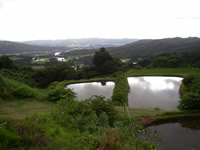
Beautiful view from Genjiro Koi Farm
Kodama:
Wonderful idea. Beauty of Koi can be improved by mixing with other lines and varieties. But there is also a chance that the good points and beauty level turn for the worst. I believe that it is very critical for the industry to preserve the beauty when it reached the point like your Sadazo Sanke and I strongly support your idea.
Kobayashi:
Thank you. I am the fourth generation since my great grand father started this business and I would like to keep the tradition and achievement that he, grandfather and father has made.
Kodama:
I am sure you will have more and more customers.
Kodama:
Now, please tell us about your production.
Kobayashi:
About the Sanke, I have two pairs.
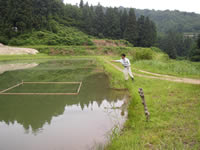
Mr. Kobayashi feed Koi.
Kodama:
How many can you produce from them?
Kobayashi:
I can get about 600,000 fry. I select 200,000 and release them to6-7 ponds. By fall, I cull them three times and keep about 2000 of them.
Kodama:
Every year?
Kobayashi:
Yes. I breed only the 2 pairs because I also breed other varieties like Kohaku, Showa, Kujyaku, Kikusui etc..
Kodama:
In other words, you breed only 2000 direct descendants of the Sadazo Sanke every year.
Kobayashi:
Yes. I can breed more if I want. But if I want to breed good quality koi, I must be very strict in culling.
Kodama:
How do you sell the 2000?
Kobayashi:
Well, about half for Japan and the other half for the outside world.
Kodama:
So that means you export only 1000, doesn't it?
Kobayashi:
Yes. They are very precious; please take care of them well. Because I export them to Europe, Asia and the US, there are usually only 300 for the US market. Very valuable.
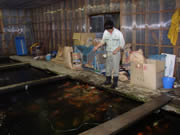
Mr. Kobayashi checks 2 year-old. They are going to be exported to the US.
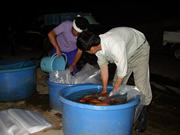
They start packing Koi at 4AM in the morning.
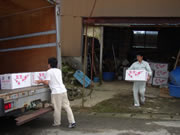
Genjiro Koi now departs to the US.
Kodama:
I agree. I will do my best to introduce the preciousness and the value of your Sadazo Sanke. Thank you very much for your time today.
We have koi available to buy from Iwashita Koi Farm online if shown below the search field. If not, contact us with what you're looking for and we'll help find the right koi.
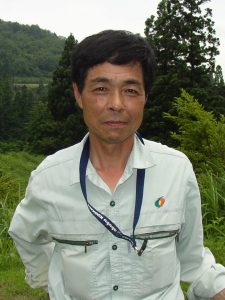
We couldn't find any products in our online store for your search in our Genjiro Koi Farm catalog,
BUT we may have inventory at the farm or in Japan, so please use the "Request a Koi" form to help us find your perfect koi fish.
Koi Auctions Ending Soon!
Place your bids now to win your choice of beautiful Japanese koi for sale at a great price! We always have a variety of fixed price koi and consistently run koi auctions ending daily; with most special auctions ending on Wednesday and Sunday each week.
-
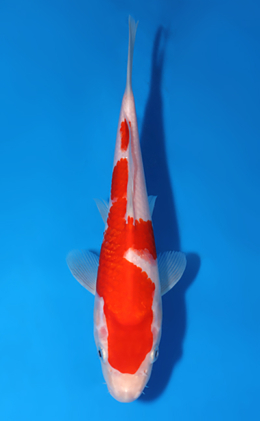
Kohaku – koi #x0627a026
Starting bid: $120.00Time left:Login / Register to BidEstimated Value: $400.00Breeder(s): Dainichi Koi FarmSex: MaleBorn in: 2024Size: 10.24 inch / 26 cmVariety: Kohaku, -
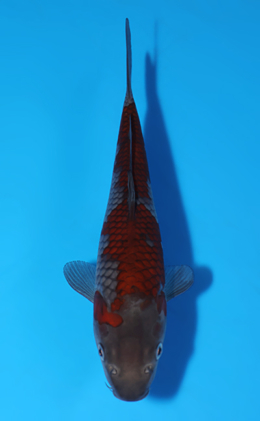
Ochiba Shigure – koi #x0627a016
Starting bid: $80.00Time left:Login / Register to BidEstimated Value: $300.00Breeder(s): Kanno Koi FarmSex: UnknownBorn in: 2024Size: 7.48 inch / 19 cm -
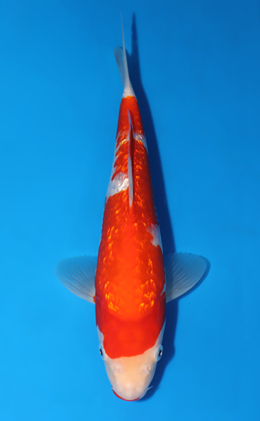
Ginrin Kohaku – koi #x0627a015
Starting bid: $80.00Time left:Login / Register to BidEstimated Value: $300.00Breeder(s): Maruhiro Koi FarmSex: MaleBorn in: 2024Size: 9.45 inch / 24 cm -

Doitsu Sanke – koi #x0627a017
Starting bid: $80.00Time left:Login / Register to BidEstimated Value: $300.00Breeder(s): Hiroi Koi FarmSex: UnknownBorn in: 2024Size: 7.87 inch / 20 cm
